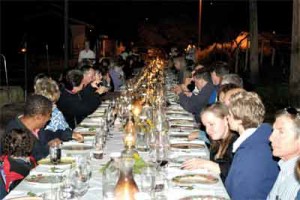 Laura and Monte Bledsoe with Governor Brian Sandoval and Assemblyman Cresent Hardy [Photo courtesy Laura Bledsoe] Read Farm-to-Fork Fiasco and watch videos Listen to Food Rights News podcast Read NourishedKitchen.com blog post by Jenny McGruther |
On July 1, 2013, Nevada’s Farm-to-Fork law (Assembly Bill 200, AB200) went into effect. The driving force behind the new law were FTCLDF farmer members, Laura and Monte Bledsoe of Quail Hollow Farms in Overton.
In a widely publicized raid, an inspector from the Southern Nevada Health District (SNHD) interrupted a farm-to-fork dinner at the Bledsoes’ farm on October 21, 2011, and ordered the destruction of hundreds of pounds of food. Shortly after the event, Laura Bledsoe wrote to those attending the dinner, “We have been compelled to truly become active participants in the ongoing battle over our food choices.” The Bledsoes’ payoff for their work on the political level came when Nevada Governor Brian Sandoval signed the farm-to-fork bill into law.
During the 2011 raid of Quail Hollow Farm, SNHD threatened to call the police and have them escort the guests off the property if the Bledsoes didn’t destroy the food prepared for the event. Reasons for the destruction order included that some of the meat was not USDA-inspected, vegetables prepared in advance of the event were considered a “bio-hazard”, and the Bledsoes did not have receipts for the food served at their event. Inspector Mary Oakes refused the Bledsoes’ request to feed the food to their animals; instead, she demanded that bleach be poured on it.
Eventually Laura Bledsoe asked Inspector Oaks to the leave the property after calling the FTCLDF hotline; attorney Gary Cox informed Laura that Oakes had no right to be on the property without a search warrant or an arrest warrant, neither of which the inspector had. The Bledsoes wound up saving the event by having their chef cook up a new batch of food; Oakes unsuccessfully tried to have the police issue a citation for carrying on with the dinner.
The reason Oakes set foot on the farm was because SNHD required that the Bledsoes have a “special use permit” (also called a “food establishment permit”) but would not issue the permit until Oaks conducted an inspection.
The new farm-to-fork law would exempt farms in certain circumstances from the food establishment permit requirement: farmers may serve poultry or rabbit meat that is “raised and prepared on the farm, and is butchered and processed on the farm” in accordance with Nevada law. The exemption also allows for other foods that “are prepared on the farm from ingredients that are substantially produced on the farm”; this includes salads, side dishes and desserts.
 Farm Food Freedom Club members enjoy an uninterrupted dinner in 2012 [Photo: Mike Bowers] |
Under the exemption a farm holding a farm-to-fork event (i.e., “an event organized on a farm where prepared food is provided for immediate consumption to paying guests”) must register with the “health authority” and may hold no more than two farm-to-fork events in any month. The farm must also provide each guest with a notice stating that “no inspection was conducted by a state or local health department of the farm or the food to be consumed” (farm raising meat and poultry may be inspected under other Nevada law).
Assemblyman Cresent Hardy who was the chief sponsor of AB200 indicated that, while supporters of the bill didn’t get everything they wanted, there would be other opportunities to expand the exemption. Through passage of the farm-to-fork and cottage food bills in Nevada and elsewhere, the amount of unregulated farm-to-consumer commerce is increasing in the country. The regulatory barriers to entry are easing for a number of local food producers; unless the FDA Food Safety Modernization Act (FSMA) gets in the way, this trend will continue.
 Laura Bledsoe and other video clips from 2010 |
Congratulations to Laura and Monte Bledsoe for the passage of AB200 into law.